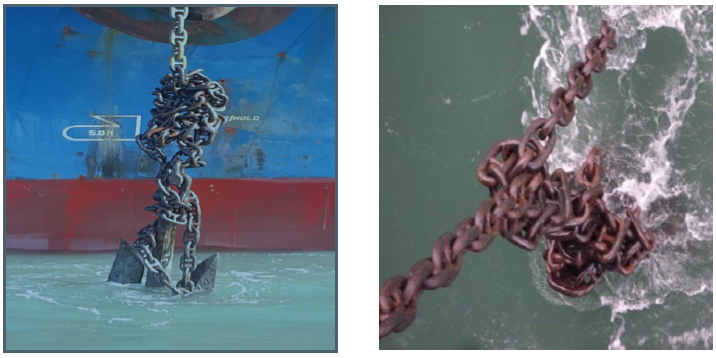Both anchors lost due to chain fouling
What happened?
A vessel had used both anchors whilst waiting for 3 days off the coast. Both chains were fouled and could not be cleared by the vessel. External assistance was provided but owing to the weather and sea conditions, the anchors could not be cleared, and both chains had to be cut. Attempts at retrieval of the anchors from the seabed were unsuccessful. The vessel lost both her anchors with one length of cable on the port and two lengths of cable on the starboard side anchor.

During anchoring and anchorage time, wind speed was less than 15 knots. There were strong diurnal tidal currents approximately 2.5 knots at the anchorage area.
Both anchors had to be cut free and arrangements made for the vessel to go alongside for repairs. The vessel was off hire for 12 days.
What went wrong?
- The Master, based on his previous experience, had the vessel use both anchors to reduce the swinging speed and angle of yaw of the vessel;
- There was inadequate discussion between the bridge team and anchoring team before anchoring;
- There was not an effective anchor watch maintained.
Recommendations to prevent recurrence
- More effective communication and meeting between bridge and anchoring teams before anchoring;
More thorough planning and risk assessment before arrival into the anchorage or when deciding to remain at anchor.
Safety Event
Published: 9 June 2017
Download: IMCA SF 14/17
IMCA Safety Flashes
Submit a Report
IMCA Safety Flashes summarise key safety matters and incidents, allowing lessons to be more easily learnt for the benefit of all. The effectiveness of the IMCA Safety Flash system depends on Members sharing information and so avoiding repeat incidents. Please consider adding safetyreports@imca-int.com to your internal distribution list for safety alerts or manually submitting information on incidents you consider may be relevant. All information is anonymised or sanitised, as appropriate.
IMCA’s store terms and conditions (https://www.imca-int.com/legal-notices/terms/) apply to all downloads from IMCA’s website, including this document.
IMCA makes every effort to ensure the accuracy and reliability of the data contained in the documents it publishes, but IMCA shall not be liable for any guidance and/or recommendation and/or statement herein contained. The information contained in this document does not fulfil or replace any individual’s or Member's legal, regulatory or other duties or obligations in respect of their operations. Individuals and Members remain solely responsible for the safe, lawful and proper conduct of their operations.
